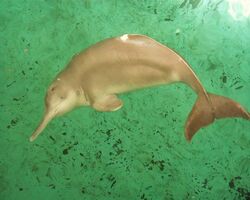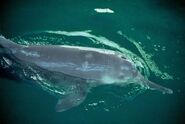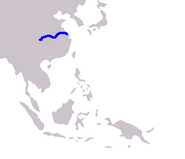(Editing a gallery) |
(Adding categories) |
||
| (3 intermediate revisions by one other user not shown) | |||
| Line 10: | Line 10: | ||
|species = '''Lipotes vexillifer''' |
|species = '''Lipotes vexillifer''' |
||
|statusimage = CR |
|statusimage = CR |
||
| + | |status = Critically Endangered}} |
||
| − | + | The baiji is a freshwater dolphin found only in the Yangtze River in China. Nicknamed "Goddess of the Yangtze" in China, the dolphin is also called Chinese river dolphin, Yangtze River dolphin, whitefin dolphin and Yangtze dolphin. It is not to be confused with the Chinese white dolphin or the finless porpoise. |
|
==Appearance-Behaviour== |
==Appearance-Behaviour== |
||
| − | |||
Baiji were thought to breed in the first half of the year, the peak calving season being from February to April. A 30% pregnancy rate was observed. Gestation would last 10–11 months, delivering one calf at a time; the interbirth interval was 2 years. Calves measured around 80–90 centimetres (31–35 in) at birth, and nursed for 8–20 months. Males reached sexual maturity at age four, females at age six. Mature males were about 2.3 metres (7 ft 7 in) (7.5 ft) long, females 2.5 metres (8 ft 2 in), the longest specimen 2.7 metres (8 ft 10 in). The animal weighed 135–230 kilograms (300-510 lb), with a lifespan estimated at 24 years in the wild. |
Baiji were thought to breed in the first half of the year, the peak calving season being from February to April. A 30% pregnancy rate was observed. Gestation would last 10–11 months, delivering one calf at a time; the interbirth interval was 2 years. Calves measured around 80–90 centimetres (31–35 in) at birth, and nursed for 8–20 months. Males reached sexual maturity at age four, females at age six. Mature males were about 2.3 metres (7 ft 7 in) (7.5 ft) long, females 2.5 metres (8 ft 2 in), the longest specimen 2.7 metres (8 ft 10 in). The animal weighed 135–230 kilograms (300-510 lb), with a lifespan estimated at 24 years in the wild. |
||
When escaping from danger, the baiji could reach 60 km/h (37 mph), but usually stayed within 10 to 15 km/h (6–9 mph). Because of its poor vision, the baiji relied mainly on sonar for navigation. |
When escaping from danger, the baiji could reach 60 km/h (37 mph), but usually stayed within 10 to 15 km/h (6–9 mph). Because of its poor vision, the baiji relied mainly on sonar for navigation. |
||
| − | == |
+ | ==Distribution== |
| − | |||
Historically the baiji occurred along 1,700 kilometres (1,100 mi) of the middle and lower reaches of the Yangtze from Yichang in the west to the mouth of the river, near to Shanghai, as well as in Poyang and Dongting lakes, and the smaller Qiantang river to the south. This had been reduced by several hundred kilometres both upstream and downstream, and was limited to the main channel of the Yangtze, principally the middle reaches between the two large tributary lakes, Dongting and Poyang. Approximately 12% of the world’s human population lives and works within the Yangtze River catchment area, putting pressure on the river. The construction of the Three Gorges Dam, along with other smaller damming projects, also led to habitat loss.They are thought to be extinct but sightings help in saying no to that |
Historically the baiji occurred along 1,700 kilometres (1,100 mi) of the middle and lower reaches of the Yangtze from Yichang in the west to the mouth of the river, near to Shanghai, as well as in Poyang and Dongting lakes, and the smaller Qiantang river to the south. This had been reduced by several hundred kilometres both upstream and downstream, and was limited to the main channel of the Yangtze, principally the middle reaches between the two large tributary lakes, Dongting and Poyang. Approximately 12% of the world’s human population lives and works within the Yangtze River catchment area, putting pressure on the river. The construction of the Three Gorges Dam, along with other smaller damming projects, also led to habitat loss.They are thought to be extinct but sightings help in saying no to that |
||
| − | == |
+ | ==Evolutionary History== |
| − | |||
Fossil records suggest that the dolphin first appeared 25 million years ago and migrated from the Pacific Ocean to the Yangtze River 20 million years ago. It was one of four species of dolphins known to have made fresh water their exclusive habitat. The other three species, including the boto and the La Plata dolphin, have survived in the Río de la Plata and Amazon rivers in South America and the Ganges and Indus rivers on the Indian subcontinent. |
Fossil records suggest that the dolphin first appeared 25 million years ago and migrated from the Pacific Ocean to the Yangtze River 20 million years ago. It was one of four species of dolphins known to have made fresh water their exclusive habitat. The other three species, including the boto and the La Plata dolphin, have survived in the Río de la Plata and Amazon rivers in South America and the Ganges and Indus rivers on the Indian subcontinent. |
||
It is estimated that there were 5,000 baiji when they were described in the ancient dictionary Erya circa 3rd century BC. A traditional Chinese story describes the baiji as the reincarnation of a princess who had been drowned by her family after refusing to marry a man she did not love. Regarded as a symbol of peace and prosperity, the dolphin was nicknamed the "Goddess of the Yangtze." |
It is estimated that there were 5,000 baiji when they were described in the ancient dictionary Erya circa 3rd century BC. A traditional Chinese story describes the baiji as the reincarnation of a princess who had been drowned by her family after refusing to marry a man she did not love. Regarded as a symbol of peace and prosperity, the dolphin was nicknamed the "Goddess of the Yangtze." |
||
| − | == |
+ | ==Genus ''Parapontoporia''== |
| − | |||
Parapontoporia is an extinct genus of dolphin in the Lipotidae family that lived off the Californian coast from the Late Miocene until the genus' extinction during the Pliocene. |
Parapontoporia is an extinct genus of dolphin in the Lipotidae family that lived off the Californian coast from the Late Miocene until the genus' extinction during the Pliocene. |
||
| Line 36: | Line 33: | ||
==Gallery== |
==Gallery== |
||
| + | <gallery> |
||
| − | |||
| − | <gallery type="slideshow" widths="500" position="center"> |
||
Baijilipotes.jpg|Baiji underwater |
Baijilipotes.jpg|Baiji underwater |
||
Baijidolphin.jpg|A Baiji |
Baijidolphin.jpg|A Baiji |
||
| Line 44: | Line 40: | ||
Lipotes vexillifer.jpg|A Baiji |
Lipotes vexillifer.jpg|A Baiji |
||
Range Baiji.PNG|Range map of Baiji |
Range Baiji.PNG|Range map of Baiji |
||
| + | Extinct creature spinner on Wild Kratts.png |
||
</gallery> |
</gallery> |
||
[[Category:Animalia]] |
[[Category:Animalia]] |
||
| Line 54: | Line 51: | ||
[[Category:Chordata]] |
[[Category:Chordata]] |
||
[[Category:Genera]] |
[[Category:Genera]] |
||
| − | [[Category: |
+ | [[Category:Dolphins]] |
| + | [[Category:Wild Kratts Animals]] |
||
Revision as of 01:25, 17 June 2020
| Baiji | |
|---|---|
 | |
| Information | |
| Range | Yangtze River China. |
| Scientific Classification | |
| Kingdom | Animalia |
| Phylum | Chordata |
| Class | Mammalia |
| Order | Cetacea |
| Family | Lipotidae |
| Genus | Lipotes |
| Species | Lipotes vexillifer |
| Conservation Status | |
 Critically Endangered | |
The baiji is a freshwater dolphin found only in the Yangtze River in China. Nicknamed "Goddess of the Yangtze" in China, the dolphin is also called Chinese river dolphin, Yangtze River dolphin, whitefin dolphin and Yangtze dolphin. It is not to be confused with the Chinese white dolphin or the finless porpoise.
Appearance-Behaviour
Baiji were thought to breed in the first half of the year, the peak calving season being from February to April. A 30% pregnancy rate was observed. Gestation would last 10–11 months, delivering one calf at a time; the interbirth interval was 2 years. Calves measured around 80–90 centimetres (31–35 in) at birth, and nursed for 8–20 months. Males reached sexual maturity at age four, females at age six. Mature males were about 2.3 metres (7 ft 7 in) (7.5 ft) long, females 2.5 metres (8 ft 2 in), the longest specimen 2.7 metres (8 ft 10 in). The animal weighed 135–230 kilograms (300-510 lb), with a lifespan estimated at 24 years in the wild. When escaping from danger, the baiji could reach 60 km/h (37 mph), but usually stayed within 10 to 15 km/h (6–9 mph). Because of its poor vision, the baiji relied mainly on sonar for navigation.
Distribution
Historically the baiji occurred along 1,700 kilometres (1,100 mi) of the middle and lower reaches of the Yangtze from Yichang in the west to the mouth of the river, near to Shanghai, as well as in Poyang and Dongting lakes, and the smaller Qiantang river to the south. This had been reduced by several hundred kilometres both upstream and downstream, and was limited to the main channel of the Yangtze, principally the middle reaches between the two large tributary lakes, Dongting and Poyang. Approximately 12% of the world’s human population lives and works within the Yangtze River catchment area, putting pressure on the river. The construction of the Three Gorges Dam, along with other smaller damming projects, also led to habitat loss.They are thought to be extinct but sightings help in saying no to that
Evolutionary History
Fossil records suggest that the dolphin first appeared 25 million years ago and migrated from the Pacific Ocean to the Yangtze River 20 million years ago. It was one of four species of dolphins known to have made fresh water their exclusive habitat. The other three species, including the boto and the La Plata dolphin, have survived in the Río de la Plata and Amazon rivers in South America and the Ganges and Indus rivers on the Indian subcontinent. It is estimated that there were 5,000 baiji when they were described in the ancient dictionary Erya circa 3rd century BC. A traditional Chinese story describes the baiji as the reincarnation of a princess who had been drowned by her family after refusing to marry a man she did not love. Regarded as a symbol of peace and prosperity, the dolphin was nicknamed the "Goddess of the Yangtze."
Genus Parapontoporia
Parapontoporia is an extinct genus of dolphin in the Lipotidae family that lived off the Californian coast from the Late Miocene until the genus' extinction during the Pliocene.
Species
P. pacifica P. sternbergi P. wilsoni







